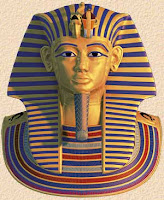Tutankhamun, the young king
The child Tutankhamoun came to the rule of Egypt, and he is in the ninth of Umrah as the youngest king in history, where he reached the throne of Egypt after the revolution that overthrew the Kenaton who drew the throne of Egypt for 21 years of 1370 BC to 1349 BC.
The young king, Tutankhamun, came in a difficult period of the country's life and was helping to facilitate the country's affairs.
"Hour Moheb" used to work as a military commander, where the army took control of the army completely to reach power, and the other was the minister "Ay", but the strangeness was at the arrival of the minister "Ay" and "Hour Moheb" to the ruling, respectively, after the death of Tutankhamun, the surprise .
The first decisions of Tutankhamun after the rule of Egypt in the first general were to return Egypt to religious pluralism and changed the name to Tutankhamun after he was the name of Tutankhaton, that is, returning to the machine Amoun and leaving you with you.
In the third year of the ruling, Egypt decided to return to the rule of before Akhenaten, as it allowed multiple beliefs and also allowed the priests to seek their various hymns openly in their temples ,And he also built a large part of the Luxor Temple.
It was one of the most important hobbies of Tutankhamun was hunting, as was the kings of the eighteenth family.
And the city of Giza, "Memphis", was famous at that time for hunting animals, and it was transferred to it to practice his favorite hobby in hunting animals, as well as to offer offerings to the ancient machine in the Giza desert, the horizon of the horizon, which represented the sun god "Sphinx."
The Pharaohs recorded the special diaries on the walls of the temples, such as visiting the god, offering offerings and achievements that occurred in a custody.
The young king, Tutankhamun, is considered one of the most Egyptian kings around whom the controversy took place in his life, then after his death, he died at a young age when the traits of masculinity began to appear at the age of twenty.
After the discovery of the cemetery in 1922, studies were carried out on the king's mummy to find out the reasons for the death, but after the DNA analysis they realized that he suffered from some distortions in his body and was unable I hit a brick fracture on one of the hunting trips, and he fell on the ground and contaminated the wound, which led to the speed of his death.
The little pharaoh was buried with the treasures that dazzled the world to live in another life. The cemetery discoverer, Harroud Carter, offered the king's holdings at the Paris Museum in 1967 to be seen by a million visitors, which makes the human person stand out of respect for the Egyptian civilization. The young king, Tutankhamun, is the last of the eighteenth family kings.

